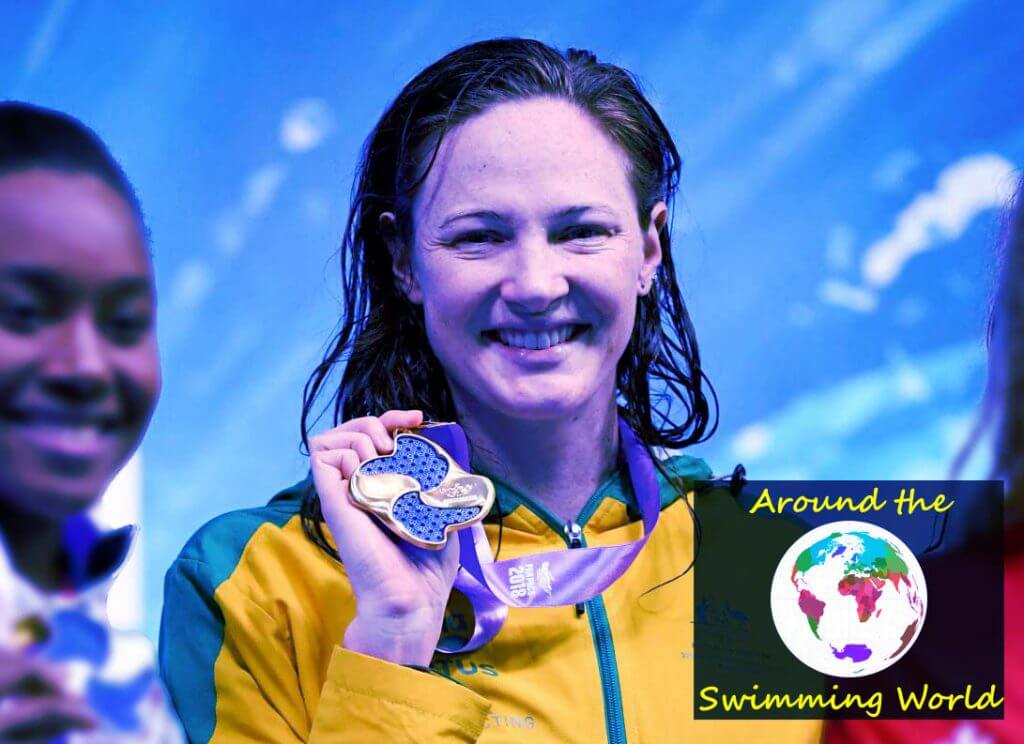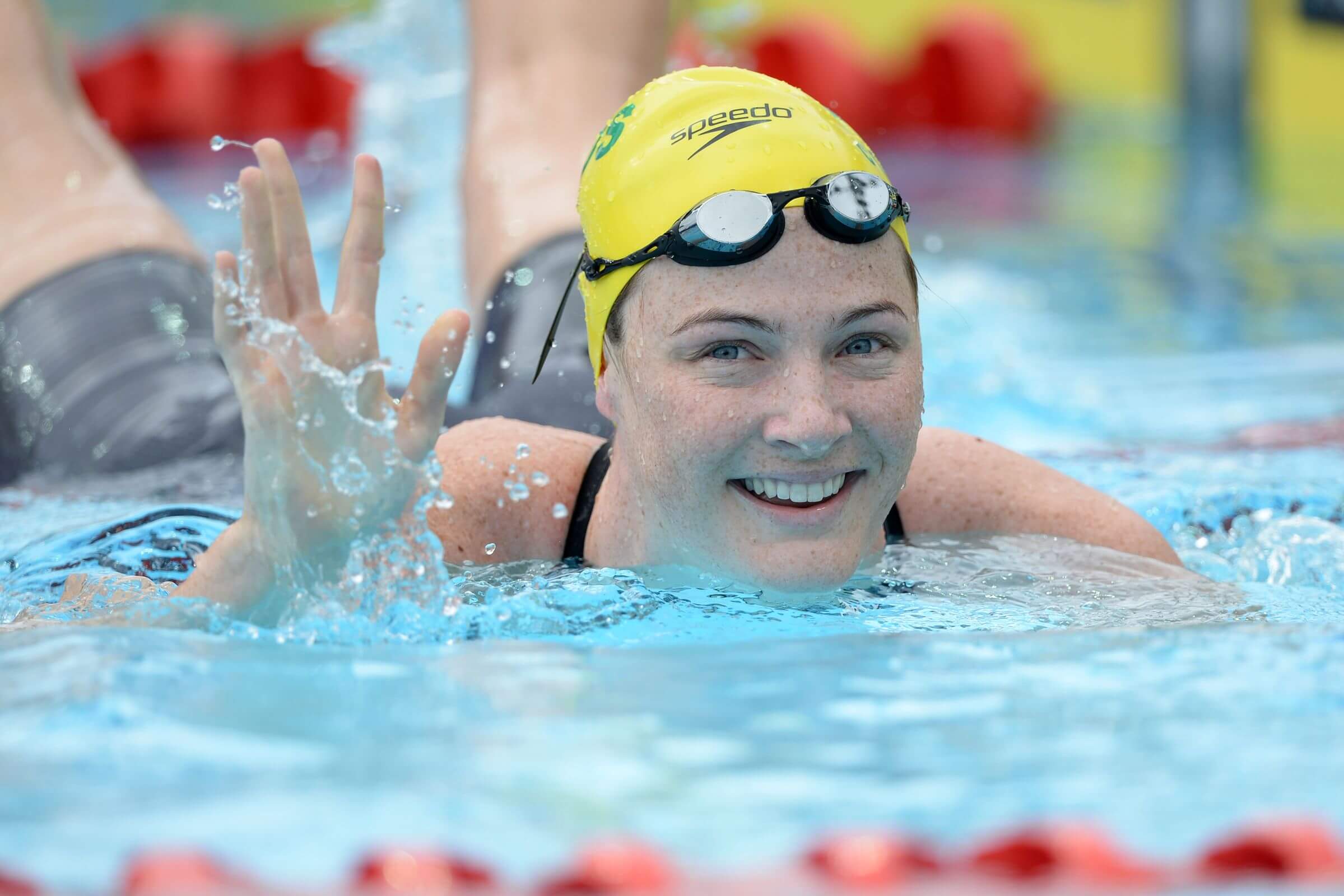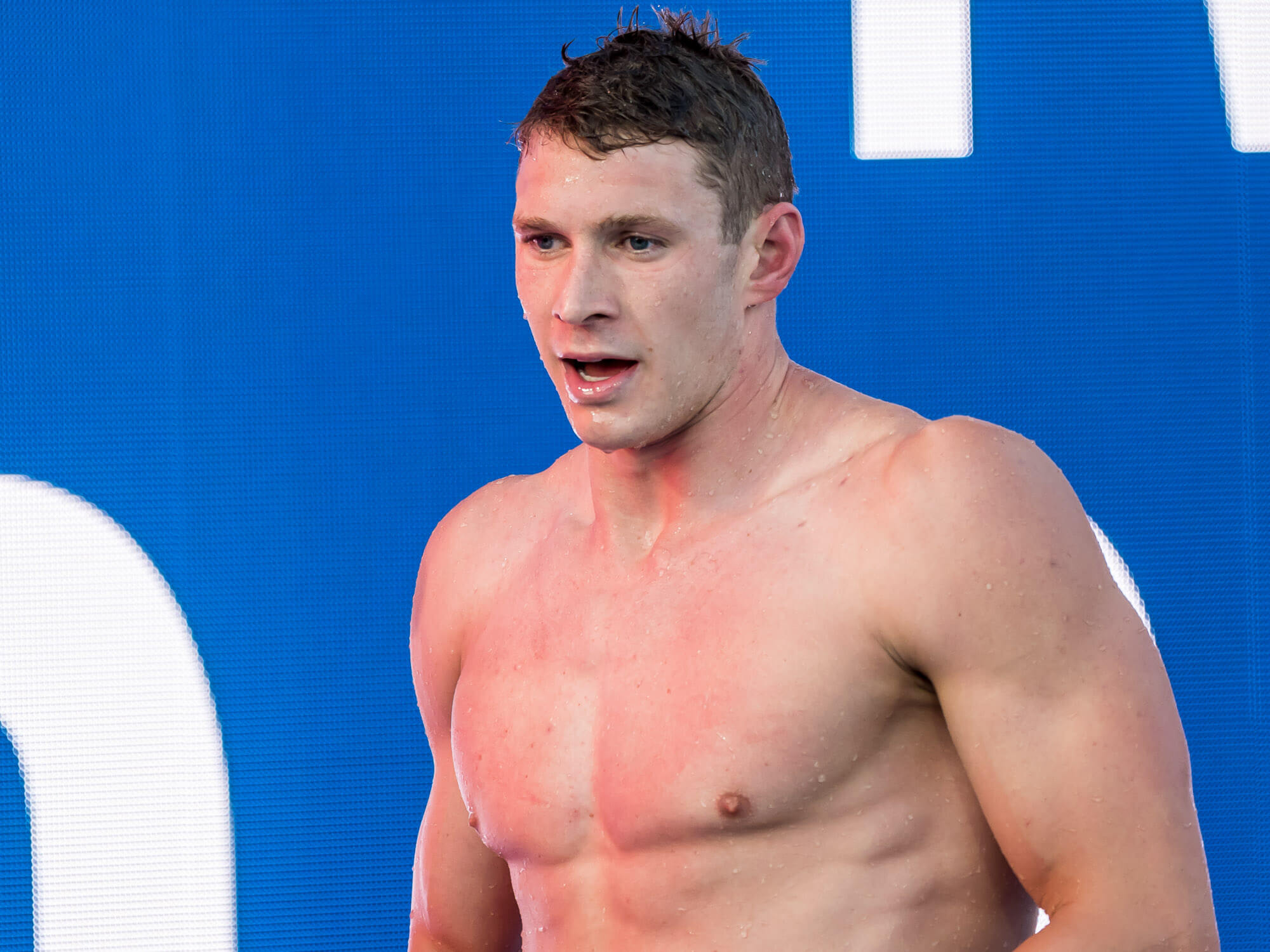Around the Swimming World: Cate Campbell’s Signature Performance at Pan Pacs

Editorial content for the 2018 Pan Pacific Championship coverage is sponsored by TritonWear. Visit TritonWear.com for more information on our sponsor. For full Swimming World coverage, check event coverage page. <script type="text/javascript" src="https://ads.swimmingworldmagazine.com/absolutebm.aspx?b=1333"></script>
By David Rieder.
Cate Campbell first swam at a senior-level international meet 11 years ago, and it took place at the Tatsumi International Swim Center. She was just 15 at the time of that 2007 Japan Open, a promising young sprinter who would be the teenage complement to dominant Aussie sprinter Libby Trickett headed into the Beijing Olympics.
When fans see a 15-year-old break into stardom, as Campbell did at Australia’s Olympic Trials in 2008, they project long-term greatness, but few actually manage to maintain that form over a decade.
For instance, just a few years after Campbell’s emergence, Yolane Kukla came along, and as a 15-year-old, she won gold in the 50 free for Australia at the 2010 Commonwealth Games. But that was her international peak. Kukla won a gold as a prelims relay swimmer at the 2012 Olympics but has hardly been heard from since.
But Campbell went on to become a three-time Olympian and swim in four World Championships. She was the World Champion in the 100 free in 2013, and she twice keyed Olympic gold medal-winning efforts in the 4×100 free relay. But her inability to capture the crown she wanted most—individual Olympic gold—left her questioning her love for the sport and all the effort she had put in over the years.
Campbell had to remind herself that two bad races did not define her swimming career. But to do that, she had to take a step back—and that meant skipping the 2017 World Championships.
“There were tears, there were many tears—I’d be lying if there weren’t,” Campbell said in 2017. “I took a step back from sport and I found other things I was good at and I enjoyed. But none of those things really filled that void that swimming had left.”
She did not swim for six weeks after the Olympics, but she smiled as she recalled her first time diving back in the water: I’m back, Campbell thought to herself. I’m home. I can do this.
But it was never a given that she would return to this level. Campbell swam five remarkable races this week at the Pan Pacific Championships—held the same Tokyo pool in which she first raced in 2007. She leaves Japan as the most decorated swimmer of the meet and with five gold medals.

Cate Campbell at the 2014 Pan Pacific Championships — Photo Courtesy: Delly Carr
Yes, Campbell did win four golds at the Pan Pacs in 2014, and the fifth this year was in the 4×100 mixed medley relay, an event new to the program this year. But it was the stunning nature of her individual triumphs and the clutch nature of her relay swims that makes this meet the signature performance of her lengthy career.
First, Campbell posted the first-ever 50-second long course 100 free split as she anchored that mixed medley relay to gold. One day later, she swam the second-fastest time ever in the 100 free—52.03, quicker than her one-time world record. Then she came from behind on the 4×100 free relay to win gold for Australia, splitting 51.36 to leave the United States and Canada in the dust.
On the meet’s final day, Campbell won individual gold in the 50 free by a whopping four tenths and then again came from behind to win gold in the women’s 4×100 medley relay.
For all three anchor legs this week, Campbell was matched up with American Simone Manuel, who shared Olympic gold in the 100 free after Campbell’s stunning collapse and sixth-place finish and then won the World title in the event one year later. On all three occasions, Campbell split at least a second faster than Manuel.
In that medley relay, Kelsi Dahlia gave the Americans a half-second lead heading into the anchor leg, but Campbell had erased that deficit 50 meters in, and then she pulled away from Manuel.
In the two years between the lowest point of her career and one of the highest, Campbell finally learned how to take the pressure off herself, to step up in the biggest moments and enjoy them.
“I kind of came to peace with whatever the outcome was going to be. For me, that’s what it all about. Win, lose, I know that I can live with whatever the outcome is. It’s just about enjoying the race,” Campbell said Friday. “Moments like these reignite your love for the sport, and they make those really hard training sessions worthwhile. They made all the sacrifices you made on a daily basis worthwhile.”
She will have another opportunity to prove herself worthy of the big state next year at the World Championships in Gwangju and another in 2020 at the Tokyo Olympics. If what happened this week is any indication, when those big moments come, Campbell will be ready.
Wet Take
Ryan Murphy won’t change his socks.
After winning Pan Pacs gold in the 200 back, Murphy admitted that he was a little superstitious.

Photo Courtesy: Peter H. Bick
“I always have the same snack before every meet,” Murphy said—a peanut butter and jelly sandwich, a banana and Greek yogurt, he added. “I’ve worn these socks for every major meet for the past four years.”
Along those same lines, this year’s Pan Pacs were particularly important because if he could swim well in the Tatsumi pool, “I think I can swim well in a pool that’s two blocks away.”
Murphy was referring to the Olympic Aquatic Center, under construction but with a roof already in place. That will be the pool where he will defend his gold medals in both the 100 and 200 back in 2020. And after a disappointing World Championships in 2017, he looks back on track for 2020.
In Tokyo, Murphy won the 100 back in 51.94, just nine-hundredths off his own world record, and he took first in the 200 back in 1:53.57, five-hundredths quicker than his Olympic gold medal-winning time from Rio.
In that 200 back on the final day, Murphy resolved to go out hard. “After last summer, I got beat pretty bad the first 100. I wanted to take it out fast this summer and see how it went,” he said.
In that 200 back final in Budapest, Murphy finished second behind Russia’s Evgeny Rylov. And even though Murphy won the event at Pan Pacs, Rylov will still finish the summer with a quicker time after his impressive 1:53.36 (a new European record) last week in Glasgow.
But Murphy did accomplish his goal: He got out fast. Check out splits from Murphy at the Olympics, World Champs and Pan Pacs and from Rylov at Worlds and the European Championships.
Murphy, 2016: 27.10, 55.56, 1:24.53, 1:53.62
Rylov, 2017: 26.37, 54.50, 1:23.78, 1:53.61
Murphy, 2017: 27.10, 56.08, 1:25.17, 1:54.21
Rylov, 2018: 26.89, 54.78, 1:24.12, 1:53.36
Murphy, 2018: 26.42, 54.87, 1:23.76, 1:53.57
Yes, Murphy faded the last 50 meters of his Pan Pacs swim—but he had already buried the field by that point. Maybe things would have been different for both men if they were racing head-to-head and could see each other out of the corner of our eye. The good news is that they will have those matchup opportunities in 2019 and in 2020.
But for Murphy, he has his confidence back—and in a relatively disappointing meet for the American team, Murphy’s return to form was the highlight.
Swimming World Japanese correspondent Hideki Mochizuki contributed reporting.





Vastly overrating Cate’s year here and seems to be a lot of self-help guru spin coming from her camp about how proud she is of herself. In flat start 50 Free, she is just third fastest in the world this year and her sister who at times has been faster than her, was out with injury.
She come away from this meet with 5 gold medals , fastest 100 this year by half a second and fastest split relay in history she has every right to feel proud , who are you to do Judge ?
Always way too much self-involved drama coming from Cate, Seebohm and Aussies generally. Cate has even posted in the past social media pictures of herself getting spirometry testing–which always leads one to believe that her year-to-year and swim-to-swim variations just depend possibly on whether her medical care or training is being modulated correctly at any given moment.
Cate’s signature performance at this meet was the use of her big yapper. Team USA had 18 gold to Australia’s 8 at Pan Pacs and what is Cate quoted as saying about Team USA after the meet? “I would say we have definitely put them on notice.”
So funny.
Interesting article. Both Campbell and Murphy so maddeningly inconsistent in past few years, ups and downs.
Murphy’s return to form was the “highlight” of Pan Pacs? Really? Were you there? Doubt that Kalisz two IM titles against tough hometown Japanese competition, Ledecky’s meet leading three indiv gold and five medals and valiant relay swim, and a couple of thriling Team USA male relays would agree.
With all the talk of Campbell’s relay split at PP, anyone know where Ledecky’s insane 1:53.84 anchor split falls in the pantheon of womens 800 Free relay splits? I know Ledecky split another crazy 1:53.74 anchor for Rio gold and that both of those splits are a lot faster than any of the splits put up by the Chinese swimmers in their World Record 4×200 relay time.